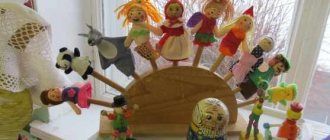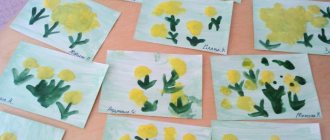Educational activity for children 2 years old “Teremok”
The fairy tale “Teremok” is one of the first that mothers read to their children. Invite your baby to play with it. We offer you the option of a developmental activity, during which the baby’s fine motor skills, speech, and thinking develop.
Take an exercise ball. Place the baby on it. Say that we are going by bus to a fairy tale. Give the child the steering wheel in his hands, he will turn it, use his hands to imitate the movement of the wheels, shake on bumps, and look out the window (hand to forehead). For this exercise, play the Zheleznovs’ song “Bus”:
Here we are sitting on the bus, and we sit, and we sit, and we look out of the window, we look at everything!
We look back, we look forward That’s it, that’s it, that’s how it is Well, the bus isn’t taking you No luck?
The wheels started spinning Just like that, just like that We rolled forward Just like that!
And the brushes rustle on the glass, Whack-wheel-wheel, whack-wheel-wheel. All the droplets want to sweep away. Whack-wheel-wheel!
And it’s not just that we’re sitting Beep-beep-beep, Beep-beep-beep, We’re all buzzing loudly, loudly Beep-beep-beep!
Let the bus shake us Just like that, just like that We're moving and moving forward Just like that!
Here we are. house in front of the child . We made such a house for our child, covering it with fabric. All windows open with Velcro, this activity is very useful for the development of fingers. Who lives in it? We look in - no one is there.
It is very convenient to use small soft animals for the game. Let's take the mouse . She greets the baby and asks to help her. In front of the mouse there is a plate containing spikelets and grains. Spikelets can be used to make shaped pasta, and grains can be used to make beads. The mouse says that she is hungry and wants to select the grains separately. Let's help her. The child selects beads and puts them in a bottle with a narrow neck. They took it away. The mouse sees the house and asks the baby - who lives in it? Nobody? Let's take the mouse.
A frog frog is running . Greets the child. She says that she came running from the swamp, where she has baby frogs. She talks about how good her life is there, that she eats mosquitoes and midges. How he catches them with his mouth. Shows the baby parts of the body - children look at the eyes, mouth, paws, tummy. Talks about how she grew up. We show the child cards (tadpole, frog with a tail, adult frog).
We do finger gymnastics with the child:
Five little green frogs (We bend and straighten our fingers) They are in a hurry to rush into the water (Fists down, we move our fingers) They were scared of the heron (We show the heron with our hands) Five green little frogs (We bend and straighten our fingers) They lie like pebbles (Fists lie on the table) Not a bit of them is visible ! (Close our eyes with our hands)
The frog says that he wants to go to his home. We invite the child to make hummocks for the frog, along which it will jump into its swamp. For this game, prepare cotton balls (bumps), tweezers, and candy molds. The child takes a cotton ball with tweezers and puts it in a candy mold. When the road is ready, the frog jumps over the bumps. Invite your baby to also jump like a frog. Lay out sheets of paper on the floor - bumps. We jump from one side of the room to the other. The frog sees the house and asks: “Who lives in the house?” The kid replies that the mouse is a bitch. “Let me live with you.” The frog comes in.
A hare runs along the path . What does a bunny like to eat? That's right, carrots and cabbage. We play the game “Feed the Bunny” with our child. We take an opaque bag containing carrots (can be cut out of cardboard, or just long sticks) and cabbages (round balls or cardboard circles). The child puts his hand into the bag and by touch takes out a carrot, for example. To treat the bunny.
Having seen the house, he also wants to live in it. Selim and the bunny.
A little fox is running - her red sister. He wonders if the baby has seen a bunny. Did he run here? "I want to eat it." Invite your child to play the game “The Fox and the Hare”. Mom catches up with the baby, he runs away. We make a hole for the hare (a chair or sofa), where he can run and the fox will not catch him. We ran and played. The fox says: “You are so fast and dexterous. I won't eat you. Let's be friends". The fox also comes into the house.
And here the wolf running. Hungry, angry. Let's feed the wolf so that he grows up. We play the game “Edible, Inedible”. We sit the wolf at a short distance. There are two plates in front of him. We will put everything edible in one, and inedible in the other. We take out various toys from the bag and run around, laying out the food. We check whether they are laid out correctly. The wolf is happy and eats. He saw a house and he went there too.
A bear is walking , waddling from side to side. We invite the child to put it on. We take the “Bear” Puzzle and select his pants and blouse to make a suit. You can also choose the mood of the bear. We change the head with different emotions. “What kind of bear do we have now? Funny. Why? He probably feels good, the sun is shining outside, he is warm and happy. Now what kind of bear? Sad? Why? He probably fell and hurt himself." The bear also wants to climb into the house. Why doesn't it fit? The bear is too big. Let's build a big house for the bear. We build a house for a bear from a construction set. He invites all the animals to his house.
Didactic game "Teremok"
Exhibition participant:
Datsyuk Olga Yurievna,
teacher
MADOOU TsRR – d/s No. 50 of the city of Tyumen
Didactic game "Teremok"
This educational game is intended for preschool children from 5 to 7 years old.
Main goal: Development of all components of children's oral speech, formation of primary ideas about objects of the surrounding world, properties and relationships of objects of the surrounding world.
The game set includes a panel in the shape of a house with opening doors, 11 pockets, sets of cards on a leg with images of letters, syllabic division of words, animals, birds.
Guidelines for implementing the game
With the help of this game you can solve problems in the educational areas “Speech development” and “Cognitive development”. It is recommended to use it as a method within the framework of organized educational activities for speech development, cognitive development, and introduction to fiction. It can be used especially successfully for individual work and for working with small subgroups of children on speech development, correction of speech development disorders. Can be used by children independently.
The game includes several didactic tasks.
1 task “Remember the fairy tale”
Task: to develop children’s coherent speech, practice using ordinal numbers.
The teacher shows object pictures of fairy tale characters.
— Guess which fairy tale the heroes came from?
- Tell this fairy tale (the child tells the fairy tale independently or with the help of a teacher).
- Who was the first to find the tower? Who came second? Third? Who came last and broke the tower?
Task 2 “Come up with your own story of the fairy tale “Teremok”
Objective: to develop children’s coherent speech, imagination, and fantasy.
The teacher offers to come up with and tell your own story of the fairy tale “Teremok” using other characters.
Task 3 “Guess whose voice?”
Objective: To develop the pitch and timbre of the voice, intonation expressiveness of speech.
The teacher depicts fairy tale characters: mouse, frog, bunny, fox, wolf, bear. The child guesses. Then the child and teacher change roles.
Task 4 “Who lives where?”
Task: Learn to use prepositions over, under, between.
The teacher places animals in pocket windows, asks them to look carefully and guess who they are?
This beast lives above the wolf. This... - This animal lives above the fox. This...This beast lives under my arm. This...This beast lives under the frog. This...This beast lives between the wolf and the hare. This... - This one is between the mouse and the bear. This …
Then the child himself makes riddles by pronouncing the words above, below, between
Task 6 “Settle the tenants”
Task: To consolidate spatial representations on the left, right, above, below.
The teacher offers to move the animals into apartments.
The mouse will live on the third floor on the left. Fox is on the second floor on the right. The bear is on the first floor on the left. The hare is on the third floor on the right. The frog is on the second floor on the left. The wolf is on the first floor on the right.
Task 7 “Select pictures with the given sound”
Task: to develop phonemic awareness, learn to isolate a given sound in a word, automate the sounds [w], [h], [ts], [l], [zh], [p] [z] in words.
The teacher puts a letter in the top window indicating the sound [w] (or another sound being assigned) and invites the child to find pictures with this sound.
Task 8 “Divide into syllables”
Task: practice dividing words into syllables.
The teacher places syllable patterns in the windows on the right side and invites the child to place residents on the left side in accordance with the pattern. - Name each resident. Clap your hands for the number of syllables in each word, and you will find out who lives in which apartment.
Share





